Sources About The Origin Of Aphrodite
Sources about the origin of Aphrodite
I will keep adding to this post (by re-blogging) each time I have something new.
I thank @junkblog101 for giving the following sources:
1) Aphrodite’s Origins: http://www.getty.edu/art/exhibitions/aphrodite/origins.html
2) Book “Transformation of a goddess : Ishtar, Astarte, Aphrodite”: https://searchworks.stanford.edu/view/10648962
3) Short description of Aphrodite/Venus figurines by the Museum of Art and Archeology: https://maa.missouri.edu/media-gallery/detail/71/322
4) A small pdf, part of a book, “The Olympian goddesses”: http://people.uncw.edu/deagona/MYTH/OlympianGodesses.pdf
My thoughts:
From those sources I have understood that there are some common elements between Aphrodite and eastern goddesses of love, but Aphrodite’s origin is still obscure.
I quote from the first: ”These divinities were associated with power, fertility, and war, and were characterized by fierce jealousy and aggressive sexuality” (For the Aphrodite figurine) “The nudity and breast-holding gesture are typical of much earlier Near Eastern figures, and make clear the importance that was ascribed to fertility and sexuality.” Also, “[Goddess Hathor’s] presence on this head (of an Aphrodite sculpture) again testifies to the Near Eastern elements that contributed to Aphrodite’s identity at Cyprus.” The last one puzzles me a little. I haven’t read it was common for gods to have other gods in their crowns. Maybe it wasn’t the goddess Hathor but Eastern people who dressed in a similar manner as this goddess?
So, their common elements were: sexuality, power, fertility, war (not so much for Aphrodite, though), nudity and breast-holding gesture. Well, those are similarities, but at the same time they don’t say much. While they clearly show some influence (nothing existed in a vacuum), they are not much, or enough to suggest the one came from the other. Influenced, would be a better word. Also, Ishtar/Astarte and Aphrodite have different “dynamics” as goddesses and different stories. I am not aware of any common stories between them (inform me if you know any, please!).
I can’t comment for the book, since I haven’t read it yet.
I don’t think the third link gives information about Eastern influence. It just states it. And while I would love to take their word for that, I would love more to have them say why or how this connection exists between the goddesses.
For the last link (and pdf) the things that I found in relation to eastern goddesses are these: “As a divine being, Aphrodite had close links with the Semetic goddess of love, Ishtar/Astarte, who was worshiped in Mesopotamia and Phoenicia. Aphrodite often bore the title “Heavenly” (Urania), while Astarte was invoked as the Queen of Heaven; and both goddesses were honored with incense altars and sacrifices of doves. Sacred prostitution, one of the best publicized aspects of the cult of Ishtar/Astarte, was also to be found in some of the centers of Aphrodite’s worship”. (Historical example of an athlete who dedicated women as prostitutes to an Aphrodite’s temple follows).
Moreover: “The Herodotus’ statement that the oldest cults of Aphrodite in Greece had been established in Phoenician settlers may contain a broader element of truth. The goddess had very strong associations with the island of Cyprus […]. And from the time of Homer onwards the epithet most commonly applied to her was ‘Cypris’, or ‘the Cyprian’. It is possible that she started life as a local Cyprian love goddess who took on some of Astarte’s characteristics when the island was colonized by the Phoenicians in the ninth century BC.[…] The reconstruction is speculative, however, for the picture of the goddess’s early development is still very unclear”.
Well, from what I gather from the last source, we know nothing for sure. If anything, the text actually suggests (with caution) that Aphrodite was a local Greek goddess and then she was influenced by cults of eastern love goddesses. And we are not sure of it either.
Why I am saying she was Greek when they say “local”? Greeks (Mycyneans) were already in Cyprus from 14th CBC*. (We are talking about Pre-historic Greeks and they lived in one of the periods of the Greek culture. Greek doesn’t necessarily mean classical Athens). As trade was happening, there were cultural exchanges between the East and the island. So again, because she was made in Greece (according to the last source), we shouldn’t say that there wasn’t any influence. There probably was. Also, people existed in the island before the Greeks came, so perhaps it was they who made the early form of the goddess. But in the Geometric era (see the Homeric epics and hymn) the goddess had already a Greek name and came from Greek gods. So, if she came from residents of the island at all, she probably came from the Greeks.
*-Thomas, Carol G. and Conant, Craig: The Trojan War, pages 121–122. Greenwood Publishing Group, 2005. - A.D. Lacy. Greek Pottery in the Bronze Age
About Aphrodite’s identity as a Greek goddess:
Now if we accept she was indeed taken (for the argument’s sake) she is still distinctly Greek. She was already part of the pantheon in the Geometric era, when the Homeric epics and hymns were written, because she is in them. Her transition period could have been in 9th-8th centuries BC and maybe a little later. Until 381AC, when Greek polytheists started getting prosecuted, the Greeks had more than a millennia to make her a Greek goddess and give her her unique attributes and stories. For more than a thousand years Aphrodite has been into Greek/Hellenic households.
I am not saying the case of Aphrodite is closed because four sources are on the table. And I still haven’t read the book (2nd link)! I am sure there will be more good info there. So the picture is not completed.
Anyone who has found additional sources, pm me or tag me! And if you have something to say about the post, feel free to reblog and add stuff! Perhaps correct me even.
More Posts from Tipsorina and Others




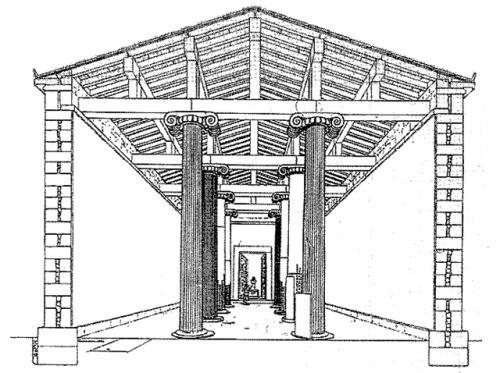

Temple of Dionysus (Temple IV)
Yria, Naxos, Greece
580-570 BCE
28,5m x 13,5 m
Ionic order (One of the earliest uses)
Around 580-570 BCE, work began on the fourth and largest temple of Yria, the only one of which remains are visible, and the only one to have been restored. It is an archaic hekatompedon (30 m. long) temple of the Ionic style. It is built of local granο-diorite rock, and it has an Adyton (innermost sanctuary for a mystery cult), marble portico (prostasis) with columns forming a monumental entrance, and a marble altar. Τwο tetrastyle marble colonnades divide the building into three aisles.
The temple is divided into three naves by two rows of four columns of Ionic order, each of which consists of two or three marble drums. The Adyton is separated from the cella by a second monumental gate. The hearth, found inside the temple, was of marble and was used for libations.
☀️Sun Meditations☀️
🌞Drawing in Sun Energy Meditation🌞:
This can be done right before any kind of Sun magic or working with Sun deities. It’s also a easy way to recharge your personal energies. If you’re tired and in need of an energy boost during the day use this exercise to recharge your energy levels. It’s also an excellent way to raise energy for any type of healing work
🌞If possible, sit outside in a sunny spot where you will not be disturbed or, if it’s cold outside, stand by a window where the Sun’s light can shine on you. Sit in a comfortable position.
🌞 Close your eyes. Feel the warmth of the sun on your skin. Take 3 deep breaths in-and-out and allow your body to relax.
🌞Turn your hands palm up, raise them to the sky (if that’s comfortable, just resting them on your lap, palms open, works just as well). See the Sun’s energy streaming towards you, and then draw it between your hands until you hold a fiery, golden orb of light.
🌞Slowly lower your hands. As you do, see the Sun’s energy filling your body. See the Sun’s energy filling your head then lower your hands to your chest and see it filling your heart in the core of your being.
🌞Lower your hands again and see the Sun’s energy fill the lower part of your body, going down the soles of your feet. Repeat as many times as you wish.
🌍Grounding Sun Meditation☀️:
This meditation is my favorite way to ground. The sun and earth work in harmony to bring you balance and strength.
🌍 If possible, sit outside in a sunny spot where you will not be disturbed or, if it’s cold outside, stand by a window where the Sun’s light can shine on you. Sit in a comfortable position.
☀️Hold your hands palms up. See a ray of golden light shining on you. Concentrate on the light. Concentrate on emotions being felt and physical sensations. Feel or imagine its warmth on your skin.
🌍Take a deep breath, and as you do, see the sunlight filling you. Take 2 more deep breaths, or until you feel filled with sunlight.
☀️Now place your hands Palm down on the ground to either side of you. Imagine reaching down through the Earth - down, down to the fiery core of the planet.
🌍Take a deep breath and, pulling up the fires that are at the heart of the Earth, take 2 more deep breaths until you are filled with the fires of the Earth.
☀️Place your palms over your heart. See the golden sunlight in the fires at the core of the Earth mix and blend as they fill in circulate through your being.
☀️Say or think:
Fires above, fires below
Within, without I am whole
Source
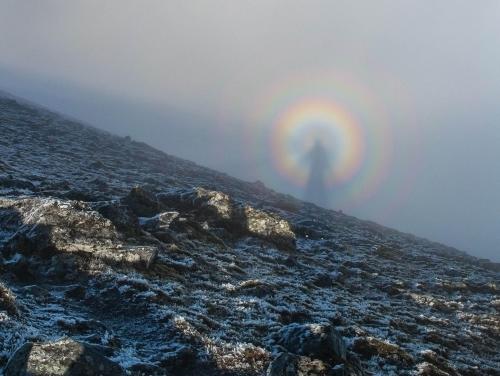
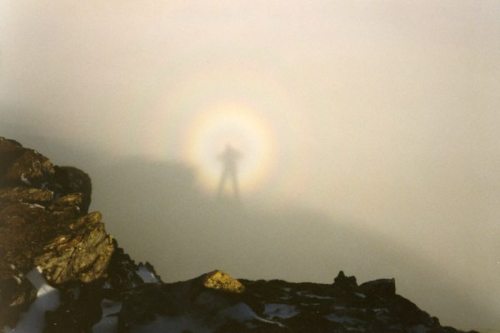
Examples of a Brocken Spectre, a phenomenon where a person’s giant shadow appears magnified onto clouds miles away. The shadow from the sun behind the person creates a halo, giving it an angelic appearance. This mostly occurs on any misty mountainsides or cloud banks, and can even be seen from aeroplanes.
Young Palestinians dance traditional dabke in the occupied West Bank city of Bethlehem - 18.10.2018










After all, many people are interested in getting started with strength training and want to know what workout routine to follow. Now, developing a workout routine for yourself can be scary, but it’s really not too difficult and kind of fun once you understand the basics.
Own a pair of professional parkour shoes, please pay attention to feiyue shoes australia on http://www.icnbuys.com/feiyue-shoes-australia.
follow back
The Moon in Motion
Happy New Year! And happy supermoon! Tonight, the Moon will appear extra big and bright to welcome us into 2018 – about 6% bigger and 14% brighter than the average full Moon. And how do we know that? Well, each fall, our science visualizer Ernie Wright uses data from the Lunar Reconnaissance Orbiter (LRO) to render over a quarter of a million images of the Moon. He combines these images into an interactive visualization, Moon Phase and Libration, which depicts the Moon at every day and hour for the coming year.
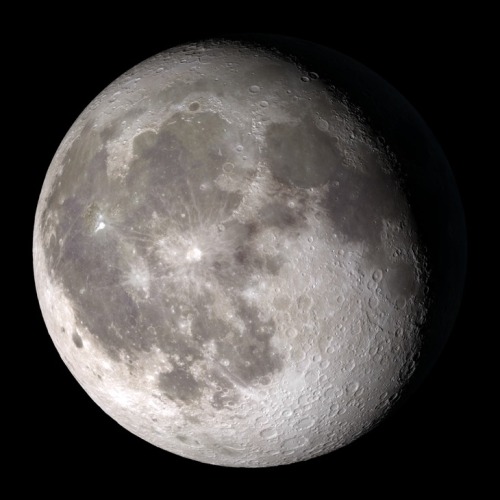
Want to see what the Moon will look like on your birthday this year? Just put in the date, and even the hour (in Universal Time) you were born to see your birthday Moon.
Our Moon is quite dynamic. In addition to Moon phases, our Moon appears to get bigger and smaller throughout the year, and it wobbles! Or at least it looks that way to us on Earth. This wobbling is called libration, from the Latin for ‘balance scale’ (libra). Wright relies on LRO maps of the Moon and NASA orbit calculations to create the most accurate depiction of the 6 ways our Moon moves from our perspective.
1. Phases

The Moon phases we see on Earth are caused by the changing positions of the Earth and Moon relative to the Sun. The Sun always illuminates half of the Moon, but we see changing shapes as the Moon revolves around the Earth. Wright uses a software library called SPICE to calculate the position and orientation of the Moon and Earth at every moment of the year. With his visualization, you can input any day and time of the year and see what the Moon will look like!
2. Shape of the Moon

Check out that crater detail! The Moon is not a smooth sphere. It’s covered in mountains and valleys and thanks to LRO, we know the shape of the Moon better than any other celestial body in the universe. To get the most accurate depiction possible of where the sunlight falls on the lunar surface throughout the month, Wright uses the same graphics software used by Hollywood design studios, including Pixar, and a method called ‘raytracing’ to calculate the intricate patterns of light and shadow on the Moon’s surface, and he checks the accuracy of his renders against photographs of the Moon he takes through his own telescope.

3. Apparent Size

The Moon Phase and Libration visualization shows you the apparent size of the Moon. The Moon’s orbit is elliptical, instead of circular - so sometimes it is closer to the Earth and sometimes it is farther. You’ve probably heard the term “supermoon.” This describes a full Moon at or near perigee (the point when the Moon is closest to the Earth in its orbit). A supermoon can appear up to 14% bigger and brighter than a full Moon at apogee (the point when the Moon is farthest from the Earth in its orbit).
Our supermoon tonight is a full Moon very close to perigee, and will appear to be about 14% bigger than the July 27 full Moon, the smallest full Moon of 2018, occurring at apogee. Input those dates into the Moon Phase and Libration visualization to see this difference in apparent size!
4. East-West Libration
Over a month, the Moon appears to nod, twist, and roll. The east-west motion, called ‘libration in longitude’, is another effect of the Moon’s elliptical orbital path. As the Moon travels around the Earth, it goes faster or slower, depending on how close it is to the Earth. When the Moon gets close to the Earth, it speeds up thanks to an additional pull from Earth’s gravity. Then it slows down, when it’s farther from the Earth. While this speed in orbital motion changes, the rotational speed of the Moon stays constant.
This means that when the Moon moves faster around the Earth, the Moon itself doesn’t rotate quite enough to keep the same exact side facing us and we get to see a little more of the eastern side of the Moon. When the Moon moves more slowly around the Earth, its rotation gets a little ahead, and we see a bit more of its western side.
5. North-South Libration

The Moon also appears to nod, as if it were saying “yes,” a motion called ‘libration in latitude’. This is caused by the 5 degree tilt of the Moon’s orbit around the Earth. Sometimes the Moon is above the Earth’s northern hemisphere and sometimes it’s below the Earth’s southern hemisphere, and this lets us occasionally see slightly more of the northern or southern hemispheres of the Moon!
6. Axis Angle

Finally, the Moon appears to tilt back and forth like a metronome. The tilt of the Moon’s orbit contributes to this, but it’s mostly because of the 23.5 degree tilt of our own observing platform, the Earth. Imagine standing sideways on a ramp. Look left, and the ramp slopes up. Look right and the ramp slopes down.
Now look in front of you. The horizon will look higher on the right, lower on the left (try this by tilting your head left). But if you turn around, the horizon appears to tilt the opposite way (tilt your head to the right). The tilted platform of the Earth works the same way as we watch the Moon. Every two weeks we have to look in the opposite direction to see the Moon, and the ground beneath our feet is then tilted the opposite way as well.
So put this all together, and you get this:
Beautiful isn’t it? See if you can notice these phenomena when you observe the Moon. And keep coming back all year to check on the Moon’s changing appearance and help plan your observing sessions.
Follow @NASAMoon on Twitter to keep up with the latest lunar updates.
Make sure to follow us on Tumblr for your regular dose of space: http://nasa.tumblr.com.
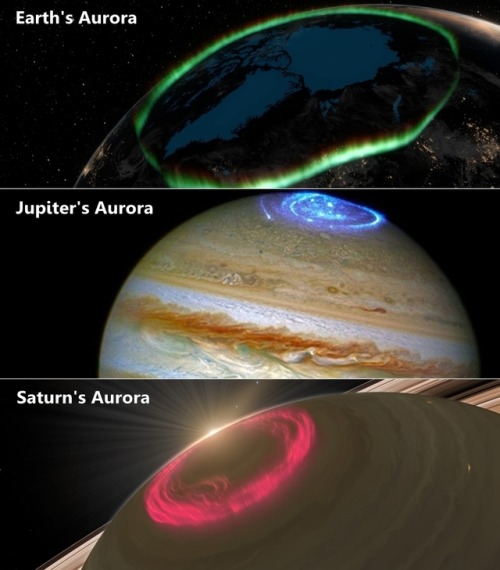
Artistic conception of the auroras os Saturn and Earth (jupiter’s image is real - ultraviolet) Instagram: wonders_of_the_cosmos
Mexico earthquake leads to discovery of ancient temple
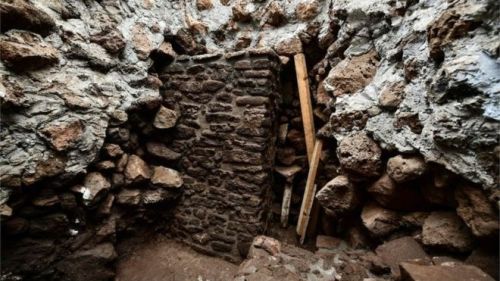
Archaeologists scanning a Mexican pyramid for damage following September’s devastating earthquake have uncovered traces of an ancient temple.
The temple is nestled inside the Teopanzolco pyramid in Morelos state, 70km (43 miles) south of Mexico City.
It is thought to date back to 1150 and to belong to the Tlahuica culture, one of the Aztec peoples living in central Mexico.
The structure is dedicated to Tláloc, the Aztec rain god.
Archaeologists say it would have measured 6m by 4m (20ft by 13ft). Among the temple’s remains they also found an incense burner and ceramic shards.
The discovery was made when scientists from Mexico’s National Institute of Anthropology and History (INAH) used a radar to check for structural damage to the Teopanzolco pyramid in Cuernavaca. Read more.

history is a subject i adore and over the years i’ve been studying it, i’ve picked up some great skills! here are my five top tips for aspiring historians out there, whether you know you’re one yet or not ;)
1. read!
no matter what you’re into, someone in history will be #relatable. want to study a gay king who kissed his gold-digging boyfriend in public? james i is right here! what about a prince who wore dresses to court? well, have you heard of philippe d'orléans? maybe you want to learn about the noblewoman who inspired dracula and bathed in the blood of local ladies! elizabeth báthory’s your girl. whatever you’re interested in, there’s someone out there who’s written about it - and learning about your course beyond the syllabus will improve your understanding as well as your writing skills! if you’re struggling to find a way to make a particular period interesting, just message a historian - i’m more of a social historian, but i’m always happy to talk about any aspect of history, and i’m sure others on tumblr feel the same!
check out:
academia.edu - papers about pretty much anything you could want to read, ranging from very accessible to heavy academic language
google books - a great starting point for literally anything, you can search “gay women 14th century” and you’ll find the historical lesbians you’ve always wanted
jstor - great for academic texts, but you can only read three per fortnight unless you sign up with a bunch of spam emails
2. take it outside the classroom!
history is all well and good in theory, but visiting historically significant locations can change your understanding completely. whether it’s a local graveyard to trace the stories of those before you or a medieval castle, visualising the lives of people you study makes the subject far more engaging (and easier to remember in the long run)!
check out:
travel journal masterpost by @stillstudies
historical days out for under £20
museums and galleries with free entry
3. make a timeline!
again, visualising history makes it so much easier to remember. whenever i start a new module of history, i make timelines by buying a huge roll of the cheapest wrapping paper i can find and taping it up onto my wall, patterned side down. i’ll make a really rough timeline of key events (e.g. my tudors timeline started with the accession of different monarchs, deaths of important people, where henry viii’s fancy led to) with big markers and then as we go through the course, i’ll add more detailed information in different colours! then, when i’m revising, i’ll tape another piece of wrapping paper over it and try and reconstruct it from memory. some people in my class use flashcards instead, with one for each year - do whatever works for you!
check out:
formatting and using flashcards by @illolita
flashcard tips by @tbhstudying
flip cards by @brokestudiesnrefs
4. make profiles of key figures!
when i was studying the american west, i found it really hard to keep track of all the generals because a) i’m about as far from a military historian as you can get and b) i hated them all. so to try and remember them, i made them into characters - some of them i doodled, some i made on the sims, some my history class acted out together. it’s a great way of forcing yourself to both research individual figures and remember little details about them - i’m a bit of a perfectionist, so looking up tiny facts about each rank to make The Perfect Sim really helped them stick in my head!
5. make your own history!
at the end of the day, it’s you that has to remember these facts for an exam. why not make a game out of it? reenact a key argument with a friend, read out preserved letters dramatically to yourself, watch historical dramas involving the figures you’re studying. if you can get yourself to remember things outside of a textbook, you’re halfway there!
check out:
studying history by @universtudy
writing history essays by @thehistorygrad
i hope you can find these useful! if you have any questions or just want to talk history, feel free to message me :)
Random Fact #915
According to Ancient Greek myth, the first spider was a woman named Arachne who bragged she could spin better than the goddesses themselves (which, if you’re not familiar with Ancient Greek culture, is a big no-no). As punishment, she was transformed into the first spider.
Spiders’ class name in taxonomy, Arachnid, is a reference to Arachne.
-
 pamelaiscrying liked this · 2 months ago
pamelaiscrying liked this · 2 months ago -
 fbi-2nd-most-unwanted liked this · 3 months ago
fbi-2nd-most-unwanted liked this · 3 months ago -
 stereotypedebunker reblogged this · 3 months ago
stereotypedebunker reblogged this · 3 months ago -
 stereotypedebunker liked this · 3 months ago
stereotypedebunker liked this · 3 months ago -
 areslahermit reblogged this · 3 months ago
areslahermit reblogged this · 3 months ago -
 areslahermit liked this · 3 months ago
areslahermit liked this · 3 months ago -
 nusa-jabber reblogged this · 3 months ago
nusa-jabber reblogged this · 3 months ago -
 core-confusion reblogged this · 4 months ago
core-confusion reblogged this · 4 months ago -
 mushroomwitchcraft liked this · 6 months ago
mushroomwitchcraft liked this · 6 months ago -
 dha-haree liked this · 7 months ago
dha-haree liked this · 7 months ago -
 sideblogforreblogging reblogged this · 1 year ago
sideblogforreblogging reblogged this · 1 year ago -
 lesbian-iphigenia liked this · 1 year ago
lesbian-iphigenia liked this · 1 year ago -
 rosebushlivin liked this · 1 year ago
rosebushlivin liked this · 1 year ago -
 acebo080 reblogged this · 1 year ago
acebo080 reblogged this · 1 year ago -
 aishabellasbigblogofeverything reblogged this · 1 year ago
aishabellasbigblogofeverything reblogged this · 1 year ago -
 aishabellasbigblogofeverything liked this · 1 year ago
aishabellasbigblogofeverything liked this · 1 year ago -
 admiralsergeantdan liked this · 1 year ago
admiralsergeantdan liked this · 1 year ago -
 electricdragon64 liked this · 1 year ago
electricdragon64 liked this · 1 year ago -
 fairyflowerx liked this · 1 year ago
fairyflowerx liked this · 1 year ago -
 magnoliessence reblogged this · 1 year ago
magnoliessence reblogged this · 1 year ago -
 seeking-kharis reblogged this · 1 year ago
seeking-kharis reblogged this · 1 year ago -
 theofaniasun liked this · 1 year ago
theofaniasun liked this · 1 year ago -
 gothicaphrodite reblogged this · 1 year ago
gothicaphrodite reblogged this · 1 year ago -
 blooxxy reblogged this · 2 years ago
blooxxy reblogged this · 2 years ago -
 ambrosiaglory liked this · 2 years ago
ambrosiaglory liked this · 2 years ago -
 coldliteraturebygalaxy liked this · 2 years ago
coldliteraturebygalaxy liked this · 2 years ago -
 cripplepride9 liked this · 2 years ago
cripplepride9 liked this · 2 years ago -
 coffee-and-crystalss liked this · 2 years ago
coffee-and-crystalss liked this · 2 years ago -
 rightwheretheyleftme liked this · 2 years ago
rightwheretheyleftme liked this · 2 years ago -
 apollogizee liked this · 2 years ago
apollogizee liked this · 2 years ago -
 imperturbitude liked this · 2 years ago
imperturbitude liked this · 2 years ago -
 deathlessathanasia reblogged this · 2 years ago
deathlessathanasia reblogged this · 2 years ago -
 captainenjolras liked this · 2 years ago
captainenjolras liked this · 2 years ago -
 dercetodebauchery liked this · 2 years ago
dercetodebauchery liked this · 2 years ago -
 aphrodite-e-shrine reblogged this · 2 years ago
aphrodite-e-shrine reblogged this · 2 years ago -
 jasperphoenixx liked this · 2 years ago
jasperphoenixx liked this · 2 years ago -
 cleopatra-223 reblogged this · 2 years ago
cleopatra-223 reblogged this · 2 years ago -
 royal-wren reblogged this · 2 years ago
royal-wren reblogged this · 2 years ago -
 indepwom101 liked this · 2 years ago
indepwom101 liked this · 2 years ago -
 henibi reblogged this · 2 years ago
henibi reblogged this · 2 years ago -
 coloricioso liked this · 2 years ago
coloricioso liked this · 2 years ago -
 archflower liked this · 2 years ago
archflower liked this · 2 years ago -
 screamgull liked this · 2 years ago
screamgull liked this · 2 years ago
